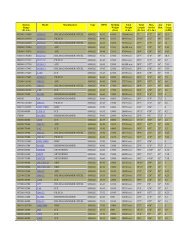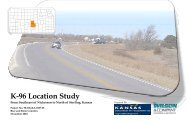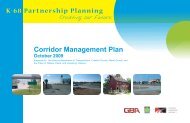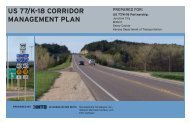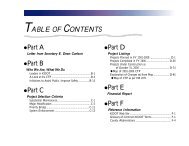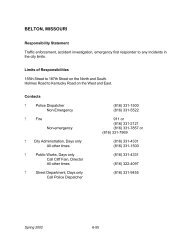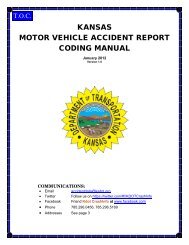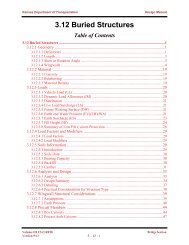Executive Summary - Kansas Department of Transportation
Executive Summary - Kansas Department of Transportation
Executive Summary - Kansas Department of Transportation
You also want an ePaper? Increase the reach of your titles
YUMPU automatically turns print PDFs into web optimized ePapers that Google loves.
35<br />
Moving Forward<br />
Johnson and Wyandotte Counties<br />
Project # 35-106-KA-2597-01<br />
O p t i m i z a t i o n P l a n<br />
E x e c u t i v e S u m m a r y<br />
June 2013
I-35 Corridor Optimization Plan<br />
<strong>Executive</strong> <strong>Summary</strong><br />
Study Purpose<br />
Interstate 35 is a vital link for interstate commerce that is subject to growing multimodal<br />
transportation needs impacting its safety, capacity, design and operation.<br />
Recognizing this, the <strong>Kansas</strong> <strong>Department</strong> <strong>of</strong> <strong>Transportation</strong> (KDOT) and the Mid<br />
America Regional Council (MARC) have conducted a corridor optimization study<br />
known as “I-35 Moving Forward.” The study examined options to keep traffic moving<br />
safely and reliably today – and in the future. The study investigated innovative ways<br />
to address I-35’s congestion issues through Johnson and Wyandotte counties. The<br />
solutions to these transportation challenges may not be “traditional” from historical<br />
standards.<br />
This optimization plan is the culmination <strong>of</strong> the study and recommends short,<br />
medium and long-term improvements for I-35 through 2040 and beyond. The study<br />
team was comprised <strong>of</strong> KDOT, MARC and an advisory group comprised <strong>of</strong> Federal<br />
Highway Administration (FHWA), as well as state, city, county and private industry<br />
representatives.<br />
Problem Definition<br />
The key challenges and opportunities identified for the I-35 Corridor include<br />
recurring and non-recurring traffic congestion (e.g., incidents and work zones),<br />
safety, truck traffic, multi-modal connectivity and geometric design deficiencies.<br />
In the future, existing problems worsen significantly as traffic volumes increase.<br />
Forecasted traffic is expected to<br />
increase 25 to 60 percent through<br />
2040 along the I-35 Corridor.<br />
The highest forecasted traffic<br />
volumes on I-35 are between<br />
U.S. 69 and I-635. When traffic<br />
is forecasted, an unconstrained<br />
assignment indicates that there<br />
is more demand than capacity<br />
in many parts <strong>of</strong> the corridor,<br />
especially north <strong>of</strong> U.S. 69 to the<br />
<strong>Kansas</strong>-Missouri state line. That<br />
means if additional capacity or<br />
operational efficiencies cannot be<br />
provided on I-35, the supporting<br />
transportation network will need<br />
to carry the additional demand.<br />
The I-35<br />
Corridor is a key<br />
transportation link<br />
in <strong>Kansas</strong> and the<br />
greater <strong>Kansas</strong><br />
City area.<br />
I-35 Corridor Optimization Plan <strong>Executive</strong> <strong>Summary</strong> - 1
<strong>Executive</strong><br />
<strong>Summary</strong><br />
Strategy Development<br />
The study team identified an initial list <strong>of</strong> over 70 potential strategies for possible<br />
application to the I-35 Corridor, designated as the Universe <strong>of</strong> Strategies. Based on<br />
technical analysis and feedback from the advisory group, the strategies were screened<br />
down to the following I-35 practical strategies:<br />
• z Fix key bottlenecks<br />
• z Managed lanes/shoulders<br />
• z Multi-modal<br />
• z Intelligent transportation solutions<br />
In addition, to these I-35 practical strategies, a No-Action and an adding general<br />
purpose lane capacity were also considered, which provided a benchmark for<br />
comparison <strong>of</strong> the benefits <strong>of</strong> each strategy. The practical strategies were first analyzed<br />
individually and then combined together as strategy packages to assess which<br />
strategies, or combinations <strong>of</strong> strategies, were most practical for I-35.<br />
Policy Considerations<br />
Each <strong>of</strong> the strategy packages <strong>of</strong>fers trade-<strong>of</strong>fs for the I-35 Corridor. In addition to<br />
the technical analysis, policy considerations were evaluated to better understand the<br />
key governance and policy changes that could be needed in order to implement new<br />
or non-traditional strategies along the corridor. A policy survey was sent out to 15<br />
KDOT staff and one MARC staff working on the project to get a better sense <strong>of</strong> how<br />
KDOT and MARC envision moving forward with improvements to I-35 over the<br />
next 30 years. Thirteen responses were returned. The policy questions focused on the<br />
following areas.<br />
1. Improvement Type — Fifty-four percent <strong>of</strong> respondents would like to have<br />
corridor-wide solutions and 46 percent would prefer a greater number <strong>of</strong><br />
smaller, localized projects. None <strong>of</strong> respondents indicated that they wanted<br />
one or two large isolated project, indicating the investment in the corridor<br />
should be spread throughout the corridor.<br />
2. Financial Level — Sixty-two percent <strong>of</strong> respondents thought KDOT should<br />
spend about the same as historical funding on the I-35 Corridor.<br />
3. Investment Approach — Ninety-two percent <strong>of</strong> respondents thought KDOT<br />
should continue traditional existing cost savings measures. Sixty-nine percent<br />
<strong>of</strong> respondents thought KDOT should toll to provide new capacity. Fifty-four<br />
percent <strong>of</strong> respondents indicated that modified design standards could be<br />
used to maximize dollars spent in the corridor. (More than one answer was<br />
possible).<br />
I-35 Corridor Optimization Plan <strong>Executive</strong> <strong>Summary</strong> - 2
4. Stakeholder Support — Eighty-five percent <strong>of</strong> respondents thought KDOT<br />
and its stakeholders would support continuing existing strategies for I-35,<br />
such as fixing key bottlenecks and adding general capacity where needed.<br />
Sixty-nine percent <strong>of</strong> respondents thought KDOT and its stakeholders would<br />
support pricing to manage congestion. Fifty-four percent <strong>of</strong> respondents<br />
supported a complete streets/multi-modal approach to solving congestion in<br />
the corridor. (More than one answer was possible.)<br />
5. Multi-Modal Level — Seventy-seven percent <strong>of</strong> respondents thought KDOT<br />
should be moderately aggressive in their support and enhancement <strong>of</strong> multimodal<br />
solutions.<br />
6. Shoulder Running — Sixty-nine percent <strong>of</strong> respondents said they would<br />
support expansion <strong>of</strong> bus on shoulder to address congestion. Fifty-four<br />
percent <strong>of</strong> respondents said they would support restricted vehicles (e.g.,<br />
transit, high occupancy vehicle (HOV) lanes, high occupancy toll (HOT) lanes<br />
using the shoulders during peak periods and incidents. Twenty-three percent<br />
felt that all traffic should use the shoulders to manage congestion and incidents<br />
during the peak periods.<br />
7. Managed Lanes — One hundred percent <strong>of</strong> respondents said they understood<br />
that a primary purpose <strong>of</strong> managed lanes was to provide sustainable reliability<br />
to the I-35 Corridor. Sixty-nine percent <strong>of</strong> respondents said they understood<br />
that one <strong>of</strong> the key goals <strong>of</strong> managed lanes was to encourage greater use <strong>of</strong><br />
transit and ridesharing.<br />
Recommended Preferred Strategy<br />
The recommended preferred strategy is based on a comprehensive analysis approach.<br />
The preferred strategy is based on:<br />
• z National and international best practices,<br />
• z Peer community interviews,<br />
• z Technical analysis, and<br />
• z Advisory group feedback.<br />
The recommended preferred strategy is to focus short-term, mid-term and long-term<br />
improvements on:<br />
• z Intelligent transportation system (ramp metering, advanced traveler<br />
information, traffic incident management and arterial dynamic message signs)<br />
z • Multi-modal (bicycle and pedestrian improvements, transit improvements<br />
including Bus on Shoulder, park and ride lots and express transit routes)<br />
I-35 Corridor Optimization Plan <strong>Executive</strong> <strong>Summary</strong> - 3
<strong>Executive</strong><br />
<strong>Summary</strong><br />
• z Fixing key bottlenecks (focused on I-35 bottleneck improvements such as<br />
interchange and auxiliary lane improvements)<br />
• z Shoulder running (restricted peak hour and incident use to some combination<br />
<strong>of</strong> transit, HOV, HOT) in concert with crash investigation sites and active<br />
traffic management lane control<br />
• z Managed lanes (priced managed lane with supporting ITS <strong>of</strong> a toll collection<br />
system)<br />
Exhibits ES-1 through ES-3 provide a graphical representation <strong>of</strong> the recommended<br />
preferred strategy improvements for I-35 Moving Forward for the short-term, midterm<br />
and long-term, respectively.<br />
Managing for Sustainable Reliability<br />
I-35 Corridor improvements are focused on balanced<br />
solutions <strong>of</strong> operating the corridor efficiently and safety,<br />
managing demand and providing multi-modal options<br />
for people in an affordable way. These balanced solutions<br />
are provided through a common theme to manage for<br />
sustainable reliability.<br />
The balanced solutions will meet the I-35 vision for a sustainable, multi-modal<br />
transportation system that maximizes the safety and efficiency <strong>of</strong> existing and future<br />
conditions in order to achieve local and regional transportation and economic goals.<br />
The balanced solutions will also address the I-35 guiding principles to:<br />
1. Move people and goods more efficiently,<br />
2. Maximize the safety <strong>of</strong> the corridor, and<br />
3. Support economic growth in the region.<br />
By achieving the I-35 vision and guiding principles KDOT is Moving I-35 Forward<br />
toward managing for sustainable reliability.<br />
Cost estimates were developed at a planning level for this study. There are<br />
no TWORKS dollars available for I-35 and implementation <strong>of</strong> the study<br />
recommendations will require future resources that have not yet been secured.<br />
I-35 Corridor Optimization Plan <strong>Executive</strong> <strong>Summary</strong> - 4
Recommended I-35 Improvements summary Costs (2012 Dollars)<br />
Capital cost O&M Cost Total Cost<br />
Short-Term (2013 – 2020) $30M $39M $69M<br />
Mid-Term (2020 – 2040) $304M $45M $349M<br />
Long-Term (2040 and beyond) $614M $89M $703M<br />
I-35 Moving Forward<br />
The I-35 Corridor Optimization Plan is intended to serve as a living document that<br />
can be reviewed and reevaluated at regular intervals by KDOT, MARC and their<br />
planning partners to monitor and respond to the evolving operations, conditions and<br />
trends <strong>of</strong> the corridor. The optimization plan is comprised <strong>of</strong> a detailed description<br />
<strong>of</strong> the preferred strategy and five individual plans focused on key future planning<br />
elements. Implementation <strong>of</strong> the preferred strategy is planned to occur in phases over<br />
the next 30 years, as corridor conditions warrant their implementation.<br />
These individual plans help guide the study team with its decision-making process<br />
for the corridor moving forward. The I-35 Moving Forward Plan is made up <strong>of</strong> five<br />
individual plans, as well as immediate next steps.<br />
• z Corridor Technical Plans<br />
• z Funding and Financing Plan<br />
• z Policy and Governance Plan<br />
• z Public Engagement Plan<br />
• z Corridor Monitoring Plan<br />
• z Next Steps<br />
The I-35 Corridor Optimization plan developed short-term, mid-term and longterm<br />
recommended improvements for the I-35 corridor in Johnson and Wyandotte<br />
Counties. In order to keep the I-35 momentum “Moving Forward,” KDOT and<br />
MARC have identified a list <strong>of</strong> cost-effective priority projects to advance the shortterm<br />
recommendations. An initial list <strong>of</strong> 15 possible projects including both projects<br />
where further study is needed and implementable projects in the corridor was<br />
developed by the study team and reviewed with KDOT, MARC and the Advisory<br />
Group. Based on feedback from the Advisory Group, KDOT will decide which<br />
projects to move forward within the short-term.<br />
I-35 Corridor Optimization Plan <strong>Executive</strong> <strong>Summary</strong> - 5
<strong>Executive</strong><br />
<strong>Summary</strong><br />
I-35 Projects Moving Forward (2013 – 2020) Next Step<br />
Possible Projects<br />
A. ITS<br />
1 Ramp Metering Implementation<br />
2 Advanced Traveler Information Public Awareness Campaign<br />
3 Enhanced Traffic Incident Management Plan<br />
4 Arterial Dynamic Message Signs Plan<br />
B. Multi-Modal<br />
5 Expand Johnson County Transit Bus on Shoulder<br />
C. Shoulder Running<br />
6 Shoulder Running Plan<br />
D. Fix Bottlenecks<br />
7 Preliminary Engineering for mainline through 75th Street<br />
8 Add a continuous auxiliary lane from SB Mission on-ramp to<br />
18th St. Expressway <strong>of</strong>f-ramp<br />
9 Detailed geometrics study <strong>of</strong> proposed improvements (Plan Plates)<br />
E. Managed Lanes<br />
10 Feasibility Study (Traffic and Revenue)<br />
F. Policy, Governance and Legislative Plan<br />
11 Develop Shoulder and Managed Lane Governance Plan<br />
G. Funding and Financing Plan<br />
12 Develop local partnership funding next steps<br />
I-35 Corridor Optimization Plan <strong>Executive</strong> <strong>Summary</strong> - 6
H. Public Engagement Plan<br />
13 Messaging the I-35 Plan to other stakeholders (community leaders, legislators,<br />
general public, interest groups, etc.)<br />
I. Performance Monitoring<br />
14 Conduct motorist survey to determine baseline satisfaction with current I-35<br />
conditions<br />
15 Establish Performance Monitoring Program for I-35<br />
KDOT and MARC accept the final report <strong>of</strong> the I-35 Corridor Optimization Study for<br />
use in the next update <strong>of</strong> the <strong>Transportation</strong> Outlook 2040.<br />
I-35 Corridor Optimization Plan <strong>Executive</strong> <strong>Summary</strong> - 7
<strong>Executive</strong><br />
<strong>Summary</strong><br />
Lenexa<br />
Shawnee<br />
Roeland Park<br />
75th St<br />
Extend 4 lane section thru<br />
75th Street in one direction<br />
Overland Park<br />
Olathe<br />
119th St<br />
151st St<br />
175th St<br />
35<br />
Homestead Ln.<br />
Legend Exhibit ES 1 — Short-Term Improvements (2013 — 2020)<br />
Transit Improvement<br />
Existing Bus On Shoulder<br />
Expanded Bus on Shoulder<br />
Existing Xpress Routes with Service Enhancements<br />
New Xpress Routes<br />
New Park and Ride Lots<br />
35<br />
MovingForward<br />
Corridor Improvement<br />
Enhanced ITS<br />
Ramp Metering<br />
Enhanced Traffic Incident Management<br />
Interchange Approach Arterial<br />
Dynamic Message Signs<br />
Transit Priority at Interchanges<br />
Local Improvement<br />
Bottleneck Improvement<br />
I-35 Corridor Optimization Plan<br />
I-35 Corridor Optimization Plan <strong>Executive</strong> <strong>Summary</strong> - 8
Hard Shoulder<br />
Running<br />
Typical Section<br />
General Purpose Lanes (Varies)<br />
General Purpose Lanes (Varies)<br />
Hard Shoulder<br />
Running<br />
Southwest Trafficway/Broadway<br />
Improvements (MoDOT)<br />
I-635 Partial<br />
Improvements<br />
1 Could be inside or outside shoulder use.<br />
Inside shoulder not shown.<br />
New Lamar<br />
Interchange<br />
Lenexa<br />
Shawnee<br />
Roeland Park<br />
75th St<br />
Extend 4 lane section<br />
thru 75th Street<br />
in the other direction<br />
Overland Park<br />
Olathe<br />
119th St<br />
151st St<br />
Extend 6 lane section near<br />
167th Street to 175th Street<br />
175th St<br />
35<br />
Homestead Ln.<br />
Legend Exhibit ES 2 — Mid-Term Improvements (2020 — 2040)<br />
Transit Improvement<br />
Corridor Improvement<br />
Local Improvement<br />
Expanded Bus on Shoulder<br />
New Xpress Routes<br />
New Park and Ride Lots<br />
Shoulder Running (includes BoS)<br />
Active Traffic Management<br />
Crash Investigation Sites<br />
Ramp Metering (extended to 175th)<br />
Interchange Approach Arterial Dynamic<br />
Message Signs (extended to Homestead Ln.)<br />
Bottleneck Improvement<br />
New Auxiliary Lanes<br />
35<br />
MovingForward<br />
Bike/Pedestrian Enhancements at Interchanges<br />
I-35 Corridor Optimization Plan<br />
I-35 Corridor Optimization Plan <strong>Executive</strong> <strong>Summary</strong> - 9
<strong>Executive</strong><br />
<strong>Summary</strong><br />
General Purpose Lanes (Varies)<br />
Typical Section<br />
Managed Lane Managed Lane<br />
General Purpose Lanes (Varies)<br />
Buffer<br />
Buffer<br />
Inside and outside shoulders not shown.<br />
Shawnee<br />
Roeland Park<br />
75th St<br />
Lenexa<br />
Overland Park<br />
Olathe<br />
119th St<br />
151st St<br />
35<br />
175th St<br />
Homestead Ln.<br />
Legend<br />
Exhibit ES 3 — Long-Term Improvements (2040 and beyond)<br />
Transit Improvement<br />
Corridor Improvement Local Improvement<br />
Incorporate future transit improvements as identified by<br />
Johnson County Transit.<br />
Priced Managed Lanes<br />
Managed Lane Access Points<br />
Transition to Managed Lane<br />
Incorporate future ITS technologies as<br />
identified.<br />
Incorporate spot improvements as<br />
identified in regional planning process.<br />
35<br />
MovingForward<br />
I-35 Corridor Optimization Plan<br />
I-35 Corridor Optimization Plan <strong>Executive</strong> <strong>Summary</strong> - 10



